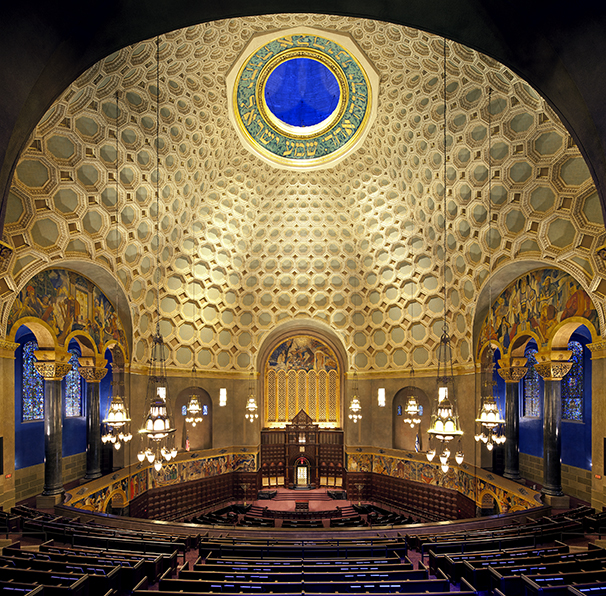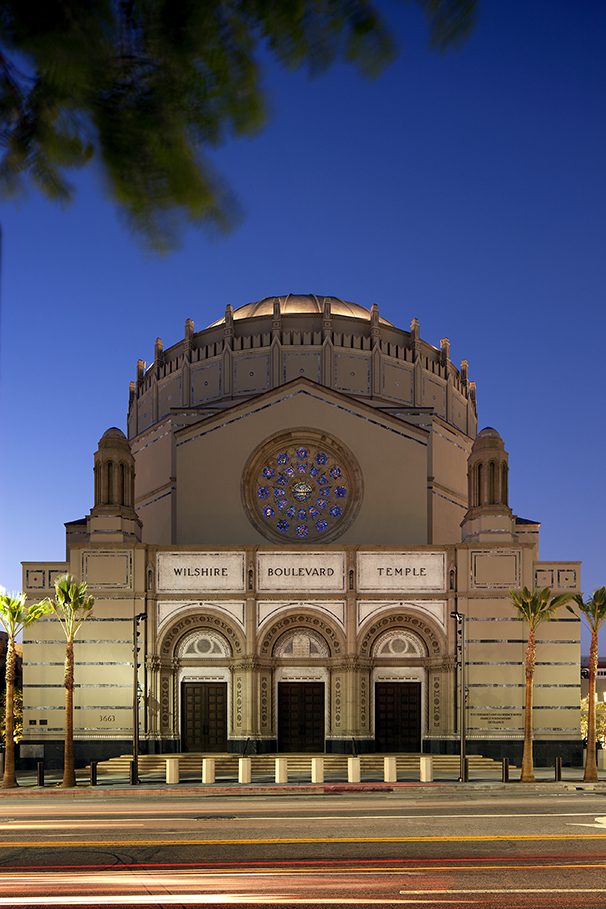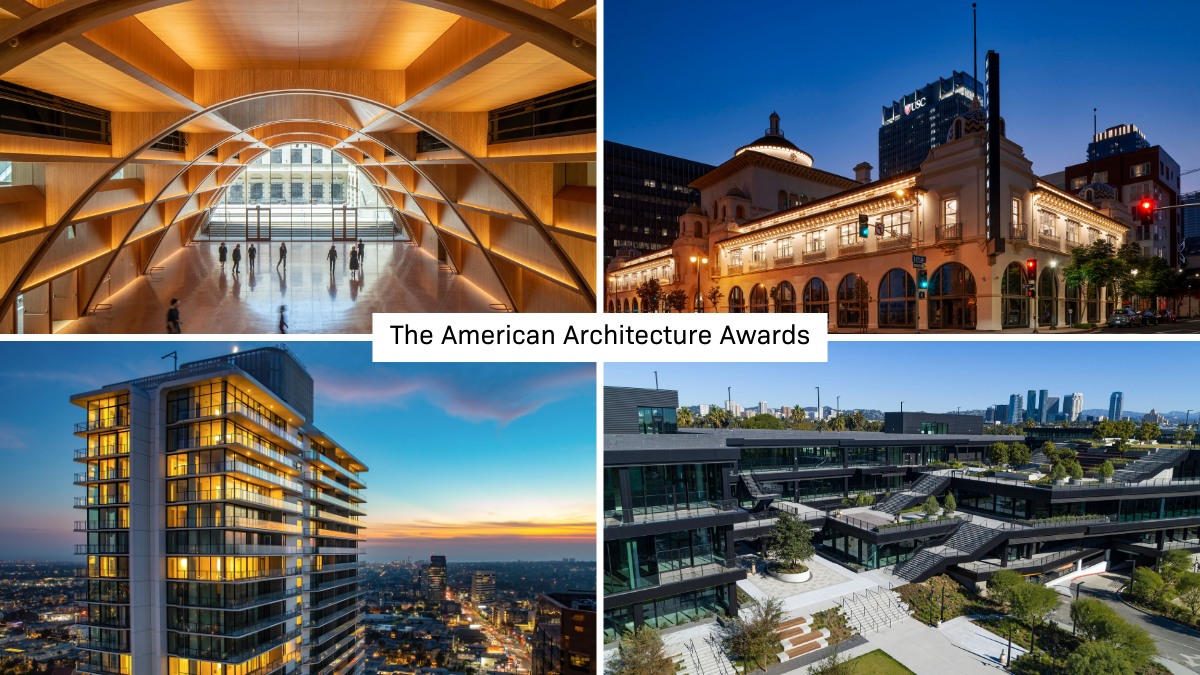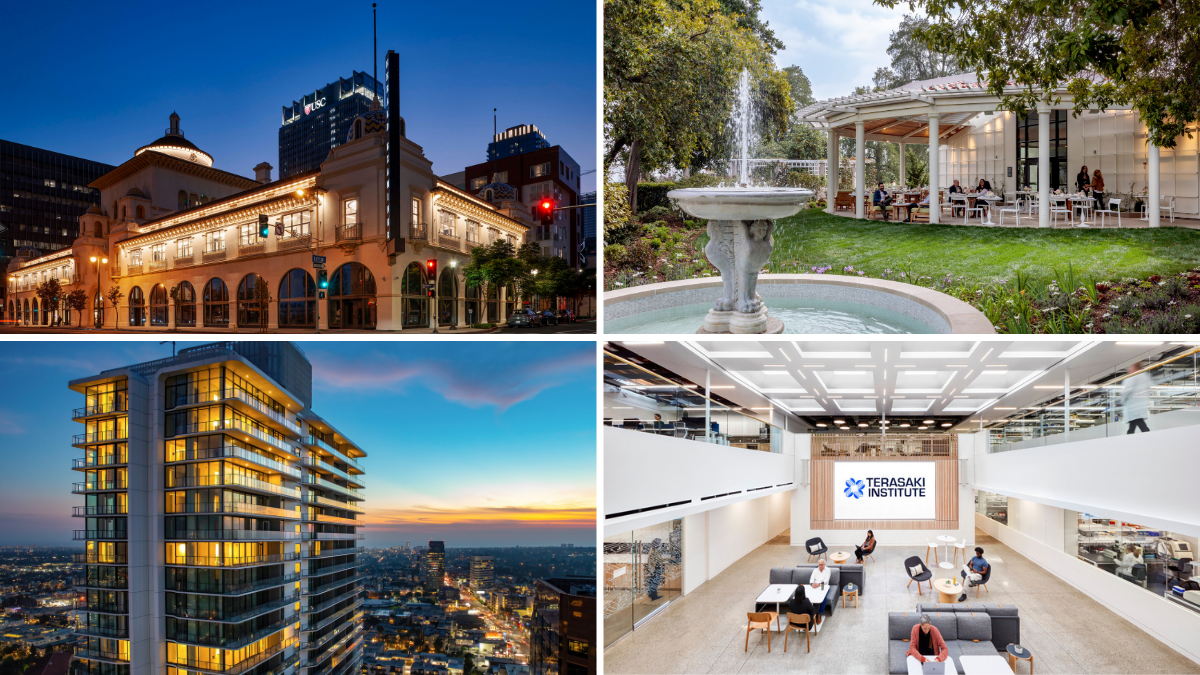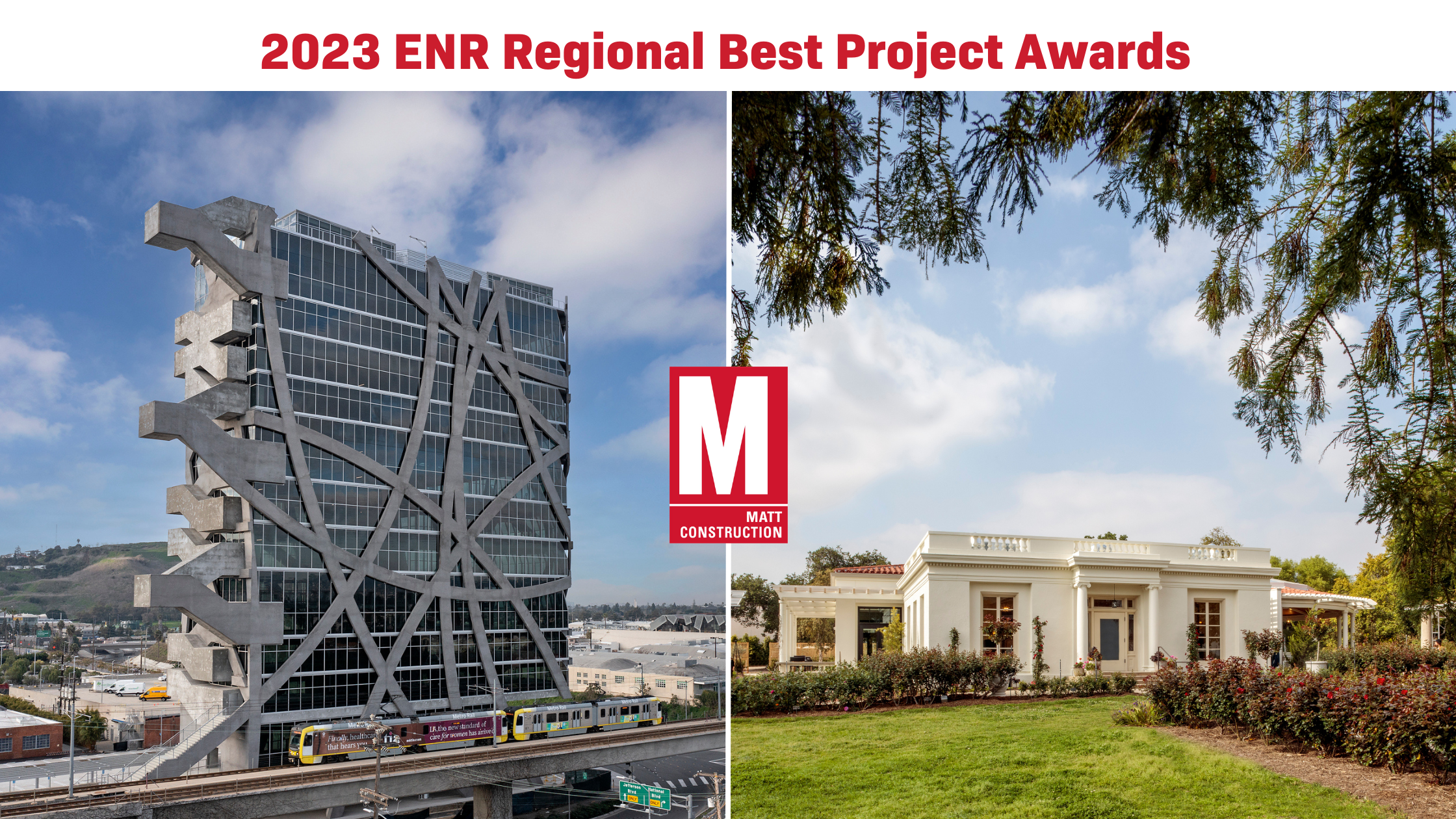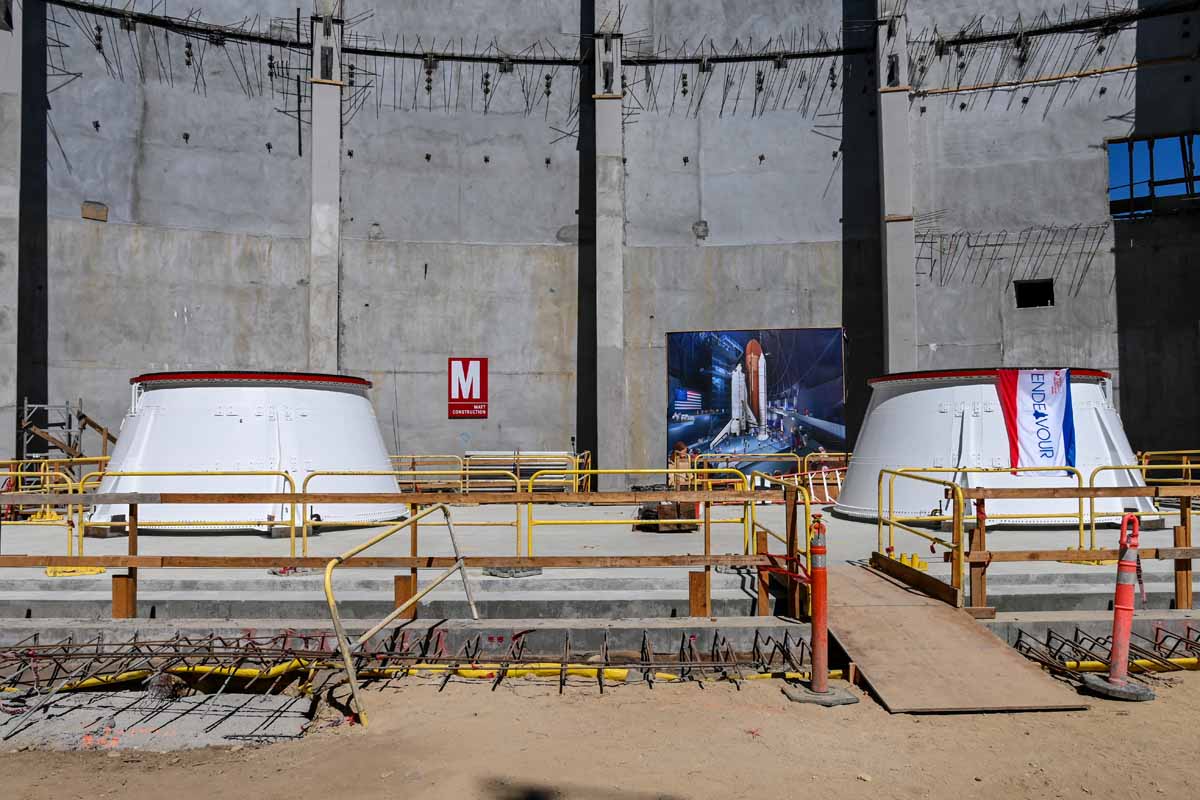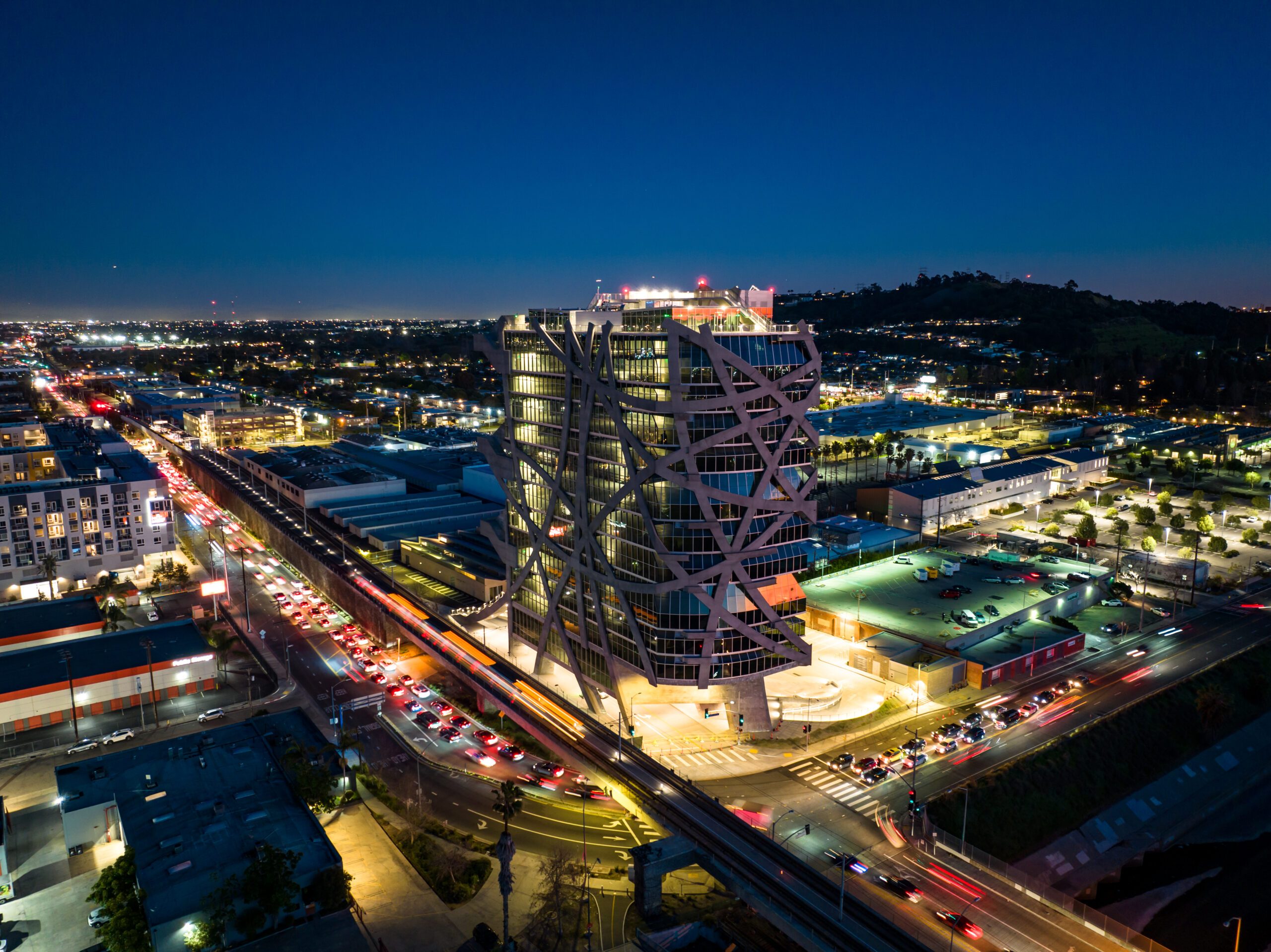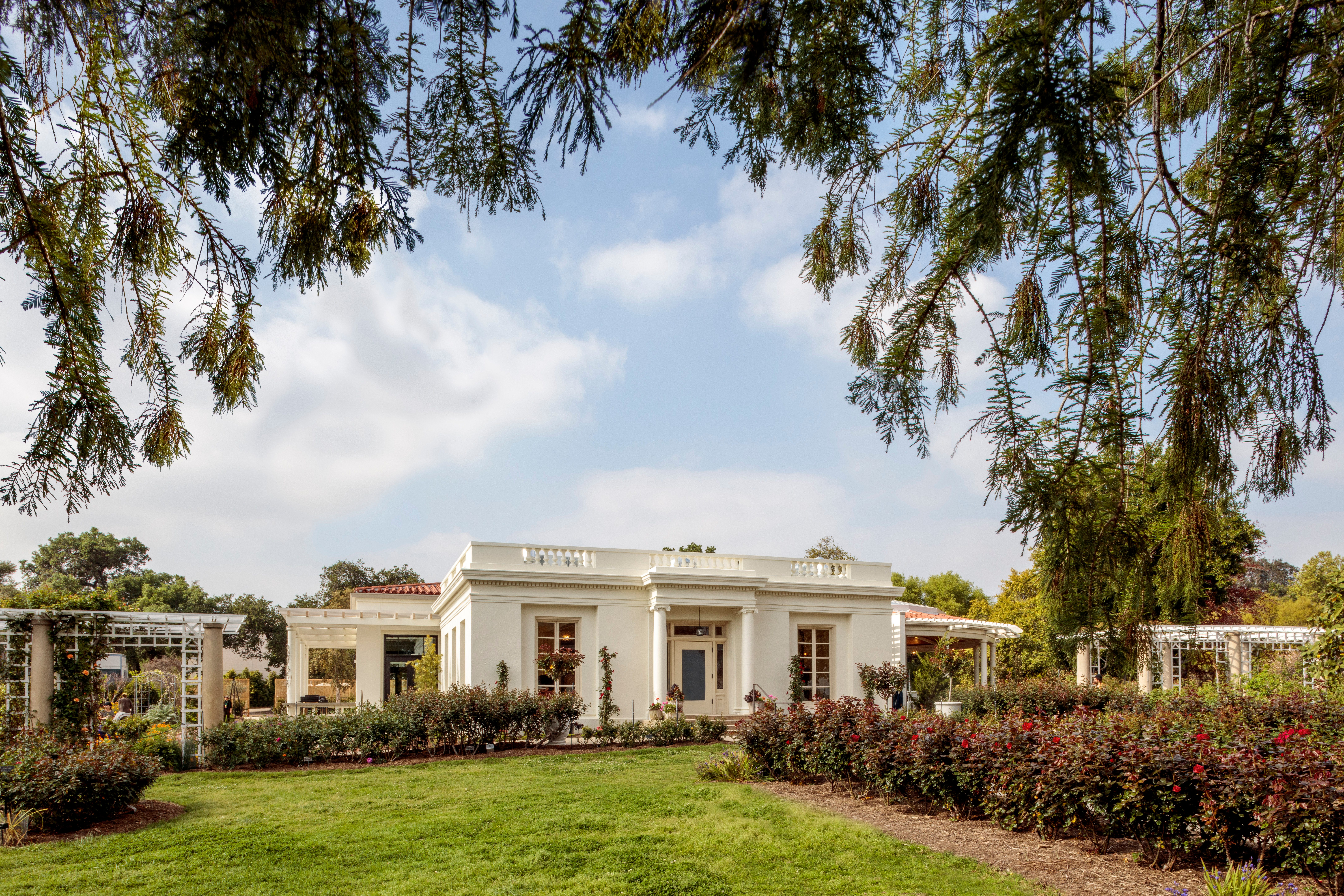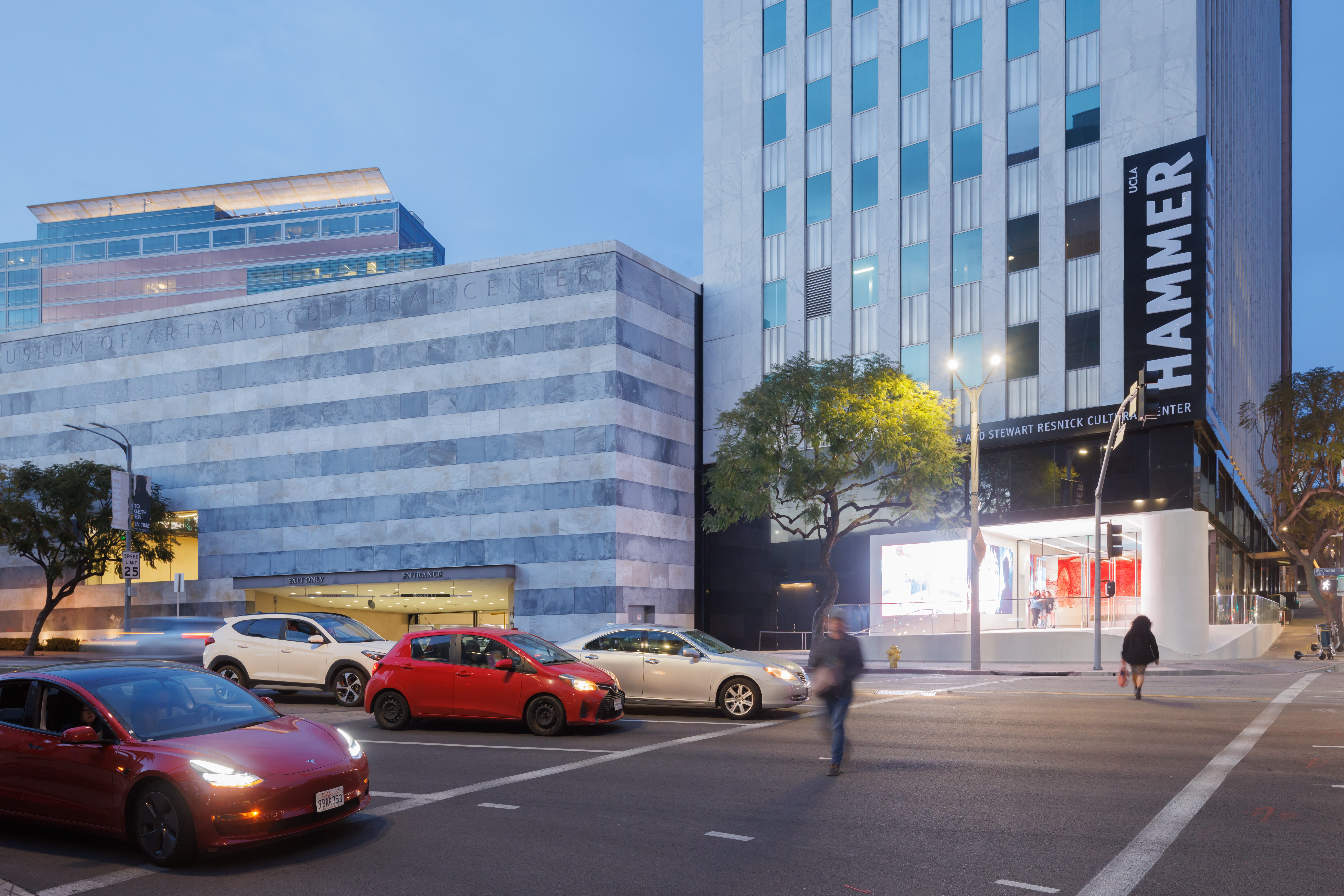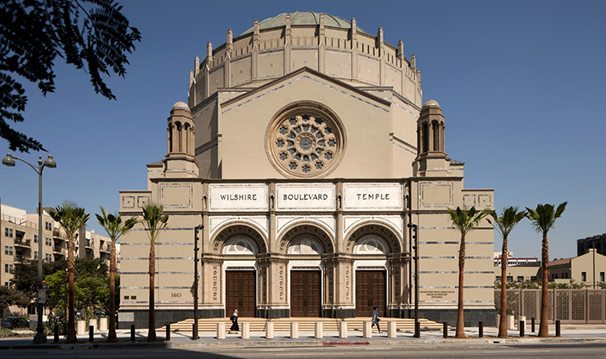
Wilshire Boulevard Temple, Restored to its Original Glory
Location
Los Angeles, CA
Owner
Wilshire Boulevard Temple
Architect
Levin & Associates Architects
Construction Manager / Owner's Rep
Searock Stafford CM
ViewWilshire Boulevard Temple: A Treasure Restored
MATT Construction has had the privilege of helping restore some of L.A.’s most beautiful historic structures to their original grandeur—but perhaps none has ever been so unique or required so much meticulous care as the Wilshire Boulevard Temple, completed last month.
The Temple is home to L.A.’s oldest Jewish congregation. It is a spectacular edifice, mingling Byzantine and Moorish architecture with “Romanesque and Art Deco overtones,” to achieve “complete elegance and sophistication of materials,” to quote the architect responsible for the restoration and revitalization, Brenda Levin FAIA, Levin & Associates.
Combining—somehow seamlessly—elements of ancient Jewish tradition with the theatricality of a 1920s movie palace, the original decoration indeed employed studio artists utilizing techniques developed for contemporary big Hollywood movies. Construction also incorporated then-current technology, meaning archaic by our standards: no air conditioning, inadequate heat, an antiquated sound system. To say the least, the resulting building is utterly unique… as were the challenges of restoring it after decades of deferred maintenance.

A bit of background will set the stage. The enormous domed temple looms alongside Wilshire Boulevard near MacArthur Park and once-fashionable Westlake. Since its construction in 1928-1929, the fortunes, and condition, of temple and neighborhood have chased each other up and down in rhythm with the economy. When it opened, before the Great Depression came crashing down, the temple reflected the theatricality, wealth and creativity of Hollywood in its heyday—and of the self-confident, self-made movie moguls who contributed money, materials and skilled studio manpower to build it. Their influence is everywhere evident, but especially in the sanctuary, a soaringly dramatic space with pews configured as though in a theatre—no central aisle, such as one usually sees in a church or temple; and, in a true break with ancient Jewish tradition, murals depicting scenes and individuals from the Torah, all painted scenic design-style by studio painters.
For decades through depression and war, Wilshire Boulevard Temple maintained its position as the temple attended by the likes of MGM’s Louis B. Mayer, Universal’s Carl Laemmle and the Warner Brothers, whose studio was then still in nearby Hollywood. But times changed. Warner Bros. and Disney moved to the roomier, less gritty Valley. Wealthy families gravitated to the cooler, greener Westside and, after awhile, Wilshire Boulevard Temple built a satellite synagogue to accommodate them. Attendance at the original temple declined apace with the general decline of the neighborhood; with them went the inclination and money to maintain and modernize the once grand building.
Though opportunities to sell the property arose—and indeed many area churches did just that—the temple remained open and operational, though crowded only on the high holy days. Neighborhood and temple hit their nadir side by side. The temple fell into such disrepair that at one point, a potentially dangerous chunk of plaster fell from the high, domed ceiling into the sanctuary, prompting immediate installation of protective netting. To the question “should the congregation raise the huge amount of money needed to rescue the old temple?,” Senior Rabbi Steven Z. Leder countered, “What would the congregation be losing if we didn’t?” With no other synagogue available to serve a huge community reaching all the way into Glendale, and with redevelopment dollars and young families, many of them Jewish, pouring into the neighborhood, Rabbi Leder realized that loss of this building would destroy an opportunity to reach new generations of Jews with the strong values, traditions and vibrant culture nourished in the Jewish faith. Reflecting on its larger meaning, he added, “If we go down as the generation that helped Los Angeles Jewry and Los Angeles as a city approach the synagogue and this place and this neighborhood with deeper gratitude and respect, then I can live with that legacy.
At the temple’s 1929 opening, its champion and senior rabbi, the late Edgar Magnin, proclaimed that the sanctuary “reveals the beauty of holiness and the holiness of beauty.” Signaling its return to its original glory, Rabbi Leder unveiled the restored temple to the media with a promise: “OK,” he said, “you’re going to see something miraculous.”
To surmount this building’s singular concatenation of complexities, the project team drew on the talents of a variety of specialists. We would like to share a few of their stories with you:
ROSE WINDOW RESTORATION
After 80 years overlooking L.A. traffic, Wilshire Boulevard Temple’s rose window needed cleaning, stabilization and seismic strengthening. To do this properly would require the removal, structural reinforcement and reinstallation of the entire window, a 25 ft diameter composition of stained glass and cast stone, weighing over 100 tons, 35 ft off the ground. Two local firms, Preservation Arts, specialists in historic masonry restoration, and the stained glass virtuosos of Judson Studios, worked together to achieve this unprecedented feat.
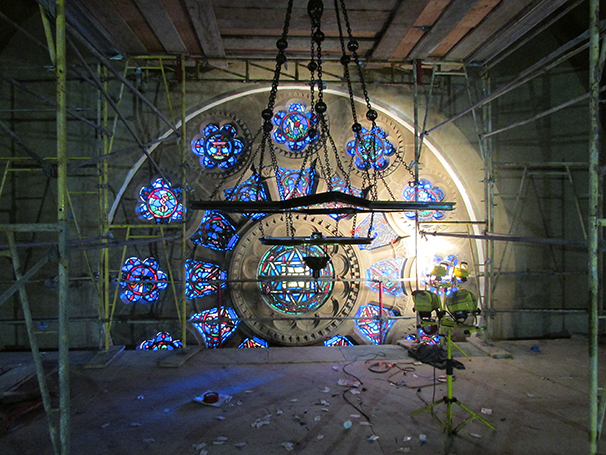
Considered an outstanding specimen of its genre, WBT’s kaleidoscopic window features a central roundel of stained glass–depicting the Star of David encircling a Torah—encompassed by two concentric rings of 12 medallions, the outermost of which represents the 12 tribes of Israel. Encircling each stained glass ring and dividing the whole into 25 panels is the richly ornamented cast stone surround.
Working atop a 35 ft scaffold, Judson craftsmen carefully removed the panels to their studios, where they were disassembled, cleaned, releaded, and sealed against weather, vibration and seismic shock.
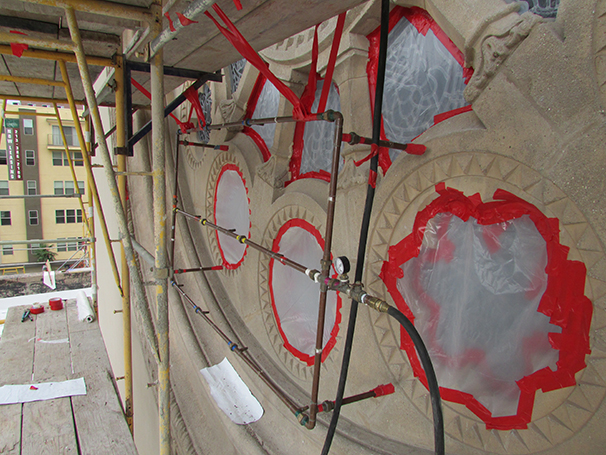
Meanwhile, Preservation Arts specialists, along with Structural Focus, engineered an effective method to restore the window’s surround of embellished cast stone. Cut apart, the surround yielded over 125 cast stone elements averaging 200+ lbs. apiece, each of which they cleaned, catalogued, drilled or even cut in half to accommodate a hidden steel matrix. Starting at the bottom of the window, they built up the structure, threading 1” steel rods through each stone in the outermost ring as it was erected into place. At the middle ring, the design devolved to a series of radial spikes which connected, finally, to a stainless steel ring sandwiched within the stone encircling the central roundel.
Judson Studios could now emplace the 25 rejuvenated stained glass panels, at last revealing the vibrancy and detail of the original design.
Powerfully dynamic yet reassuringly unchanging, the “new” old stained glass window is now poised to enhance religious observances for future generations: the crowning touch in one of L.A.’s–and the world’s–unique architectural treasures.
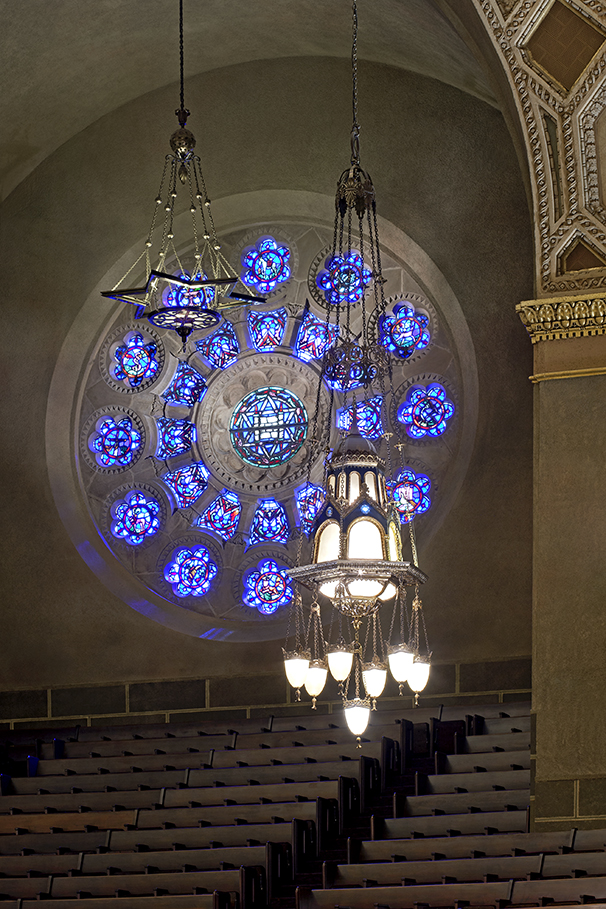
MURALS
In Wilshire Boulevard Temple’s breathtaking sanctuary, a ring of murals surrounds you with Jewish history.
These murals have an interesting history themselves. They are unique among synagogues, which traditionally forswear figural representations as counter to the Second Commandment’s prohibition of displaying “graven images.”
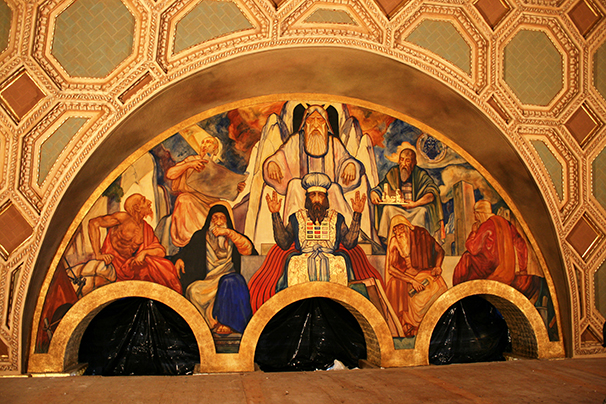
Rabbi Magnin differed: “The synagogue, particularly the reform temple is generally too cold in its treatment. We need more warmth and mysticism.” Maintaining “The day is over when liberal-minded people are likely to worship images,” Magnin wanted to turn the stirring power of imagery to the service of faith. The Warner brothers agreed. They donated $40,000 and tapped studio artist Hugo Ballin to create murals that told the story of Judaism from Genesis to when facing pogroms and exile, and their exodus to America. Painting them at the studio, Ballin affixed the canvases to the temple walls over a 3-coat plaster substrate.
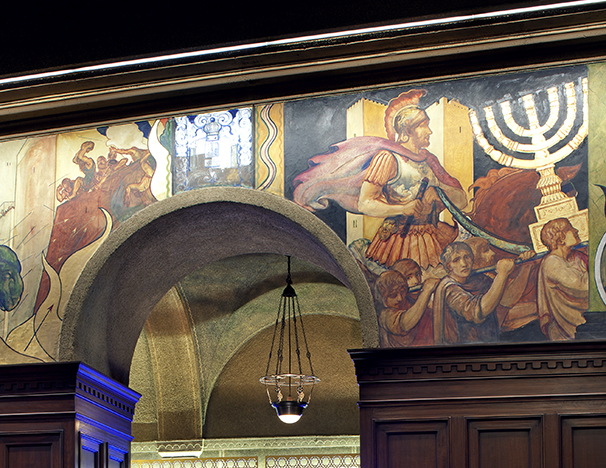
Eighty years of grime and water damage dimmed but did not defeat the murals’ power to spark children’s curiosity—Why is that town on fire?—priming them to explore their heritage.
Painting Conservators Aneta Zebala and Partners thoroughly cleaned the murals to remove surface dirt and accumulated salts, repaired the canvas, and reapplied and stabilized peeling gold leaf with a custom-formulated adhesive. Coating the canvas with a thin clear varnish they used precisely color-matched, removable “conservation paint” to fill in paint losses, including where gaps left by old ventilation grates required extrapolating from surrounding imagery to “fill in the blanks” with elements true to the artist’s original intent.
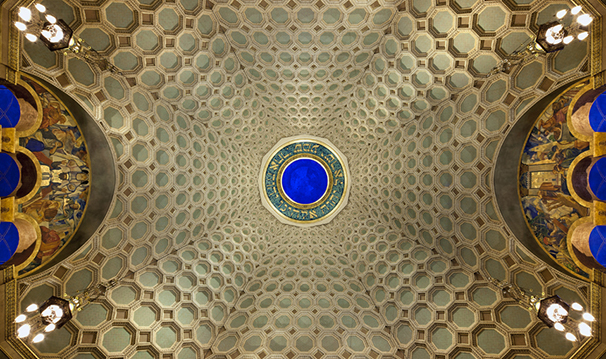
Looking with satisfaction at the restored murals, current Senior Rabbi Steven Z. Leder observed that the temple “is really meant ultimately not so much a place where one comes to encounter God, but where one comes to be inspired enough to take God with oneself out into the world. And that, ultimately, is what the power of this room is: it’s not just what happens here; it’s the effect that what happens in this room will have on people when they leave, not just when they enter.” Surrounding the congregants with vibrant examples of their faith, Ballin’s “Warner Murals” enhance the sanctuary with a power all their own.
An in-depth description of the murals can be found here.
SHEAR WALL INTERVENTION
Among the most challenging feats of Wilshire Boulevard Temple’s restoration was the invisible seismic retrofit of the building, engineered by Structural Focus, including its highly visible dome.
What seems like one dome is actually two: an outer 135ft-diameter circular dome of steel and concrete, from which is suspended an octagonal inner dome whose coffered plaster ceiling reaches 100ft above a Sanctuary accommodating over 1,600 worshippers. Structurally, the heavy dome rests on a steel-framed “drum” and the walls. Broad double-decked arches on the four cardinal sides lead from the Sanctuary to niches between the domes’ interior octagonal and exterior circular footprints. Computer simulation revealed potential failure of the octagonal sanctuary’s diagonal walls. The solution—building four new shear walls within the interior of the existing walls—would require removal of the corridor side of each diagonal wall. But every surface was embellished: The sanctuary is lined with tall mahogany wainscoting and priceless mural friezes. Even seemingly monochrome walls are actually multiple colors subtly layered to create faux effects, such as Zenitherm resembling greenish “mortared stone” lining the corridors outside the sanctuary.
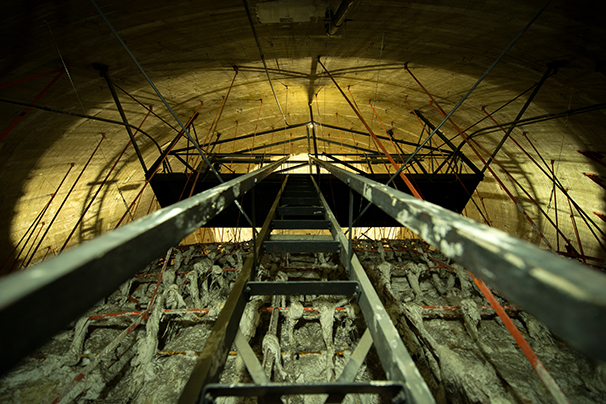
The team opted for the relatively plainer corridor walls, where the historic fabric could be more easily removed, replaced or recreated. But the construction of four new reinforced shear walls within those selected walls was anything but easy. New footings had to be hand-dug 10ft below the basement. A matrix of structural steel in-filled with shotcrete was built from the basement to the top of the drum—a height equivalent to nearly 5 stories. The corridor walls were then replaced and refinished with new plaster and decorative painting to match the original surfaces. Steve Lehne from KC Restoration was instrumental in restoring and in some instances re-creating the unique Zenitherm finish.
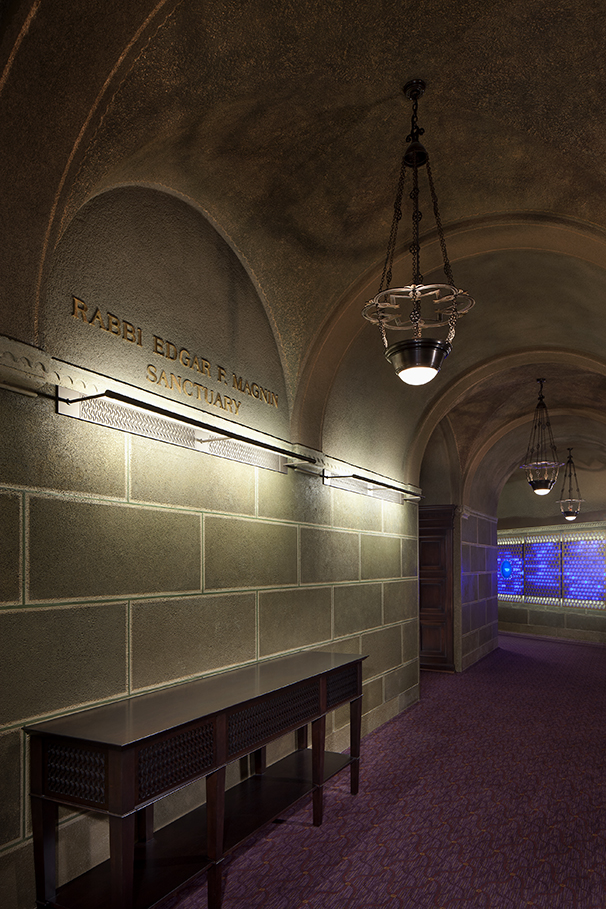
In the east and west niches, the concrete pilasters between triple lancet windows of leaded stained glass and concrete were opened up and steel Tees were welded to the flanges on the existing steel. Here, the inability to use cranes to maneuver the 30ft long, 100lb/linear foot steel sections required the team to cut them into 8ft lengths, wheel them into place on carts and hoist them into position for welding.
To complete the task, a lightweight layer of carbon fiber designed to transfer seismic loading was added to the lower part of the roof and up the exterior walls of the sanctuary encompassing the dome.
With all decorative elements restored, the seismic strengthening is wholly undetectable, preserving the historic materials, finishes and character of the space while enhancing the safety of the congregation.
AIR CONDITIONING & ACOUSTICS
At the grand reopening of the restored Wilshire Boulevard Temple, Senior Rabbi Steven Z. Leder interrupted himself to cry out, “Air conditioning at last. Air conditioning at last. Thank God almighty, air conditioning at last!” Heretofore, Wilshire Boulevard Temple’s enormous Sanctuary—large enough to accommodate over 1,600 worshipers, capped by a dome 100 ft above the floor—had been impossible to heat or cool effectively. The noisy, 1920s-vintage ventilation system, which blew air over blocks of ice into a space (plenum) below the Sanctuary’s sloping floor and upward through vents under the pews, left congregants too warm or too cold to concentrate on the services, engage in quiet contemplation of God or even simply enjoy the beauty of the sanctuary. The system was abandoned long ago and so for many years, there had been no attempt to cool or heat the space. Now a new HVAC system designed by IBE/Stantec and—vastly more complicated—carefully designed acoustic dampening measures ensured both air conditioned comfort and freedom from distracting AC-generated sounds.
The problems lurked in a basement packed with all of the building’s mechanical, electrical and plumbing systems, including air handlers, boilers, the 4,100-pipe organ’s blower, and the elevator machine room. A new HVAC compressor, and replacement air handlers, vents, and MEP would enhance comfort but generate distracting noise and vibrations.
SIA Acoustics’ initial dampening plan encountered conflicts with the planned HVAC and MEP upgrades, so MATT arranged one-on-one meetings between the acousticians and the trades to identify problems not visible in models and to revise and coordinate their plans accordingly.
Ultimately the acousticians produced a comprehensive plan for effective noise suppression. The entirety of the plenum was lined with acoustic treatments. Compressed fiberglass mats, resilient partitions, perimeter isolation board and resilient sway braces isolated MEP systems, walls and ceilings from the slab, deck, and other walls. All equipment and pipes suspended from the ceiling were mounted via acoustic-isolation hangers. Penetrations were routed through metal or gypsum sleeves sealed against vibration with acoustic caulk. Ductwork vibrations were minimized using duct wrap and acoustical duct silencers. MATT custom-designed and rigorously enforced a QA/QC inspection program to ensure each element was properly installed by its respective trade.
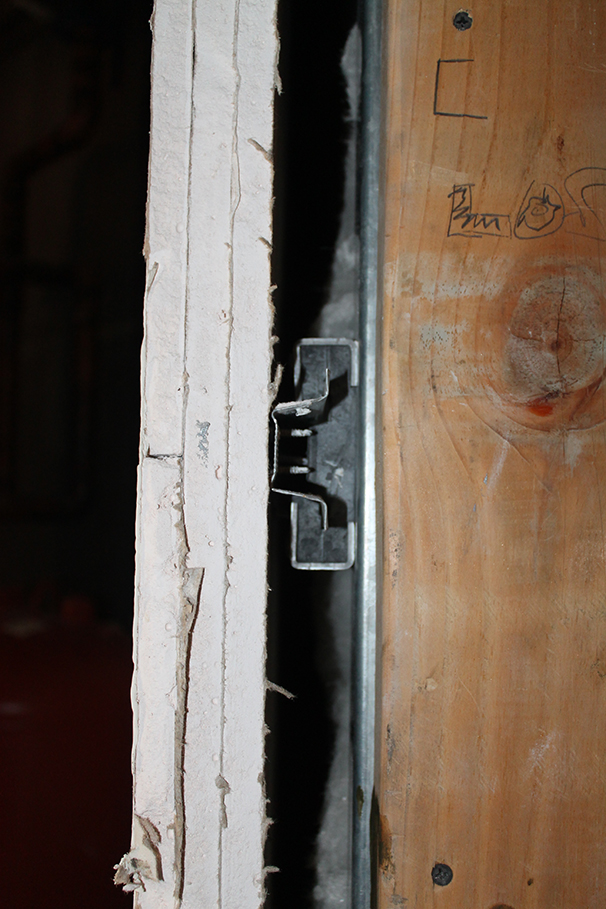
Now complete, these historically sensitive upgrades subtly enhance the congregation’s comfort without sacrificing the Sanctuary’s comforting familiarity. To quote Jewish Journal editor Rob Eshman, the “new air conditioning system literally breathes new life into the place.”
ART GLASS
When Wilshire Boulevard Temple opened in 1929, among its beauties were nearly 100 elaborate art glass windows. Each crafted of hundreds of pieces of glass and soldered cames, these windows accumulated the grime of decades and, like a superannuated starlet, progressively sagged with age. This being the temple of Hollywood’s greatest moguls, these fading beauties deserved—and got—a complete facelift. To perform the delicate operation, the MATT team tapped Judson Studios, a 5th generation family-owned and operated business whose stained glass artistry has enhanced many of L.A.’s most historic buildings.
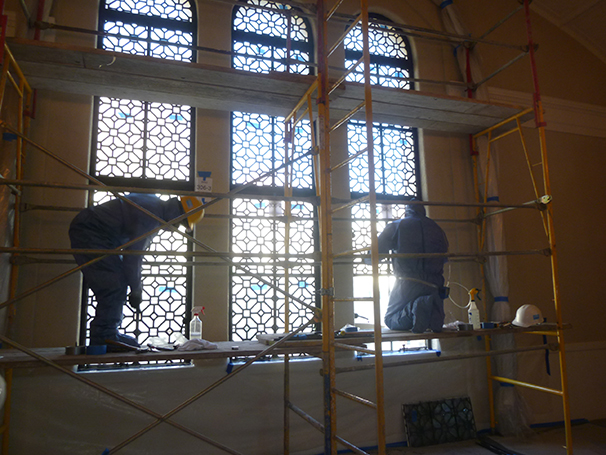
After creating full-sized annotated rubbings of each window for archival and reconstruction purposes, artists led by current proprietor David Judson carefully excised them from the temple walls. In the controlled conditions of the studio, each window was totally dismantled, each element cleaned, polished, and pieced together like a giant jigsaw puzzle atop full-sized paper template. Necessary repairs were rendered imperceptibly. Where replacements were needed, the artists selected glass precisely color-matched to the original, duplicating shading and other details by applying and drying dark pigment on the dark lines and sections of the design, gently overlaying this with a light coat of the same dark pigment over the entire surface of the piece, and lightly brushing off the excess; once this had dried, the artists delicately pared down or removed pigment to create gradations of shadow and highlight. To ensure that the pigment, like the glass itself, would never fade, the artists fused them in a 1,200 degree farenheit kiln. Any further highlights, perhaps of amber or gold, were subsequently applied and fused to the glass.
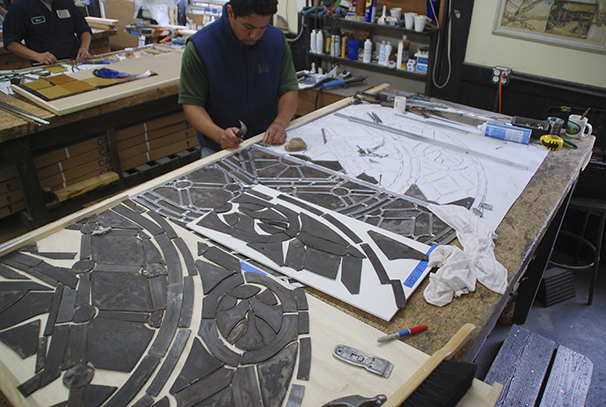
Reassembled with new cames and solder, sealed with glazing putty, strengthened with inconspicuous steel wires, and reinstalled with care, the windows are now prepared to withstand weather, seismic tremors and the daily vibrations from nearby traffic. Fully restored to their youthful appearance, these grandes dames, say the Judson experts, now have an added life expectancy of 80 to 100 years. Their classic beauty will grace the observances and occasions of generations to come… a true—and fitting—Hollywood ending.
